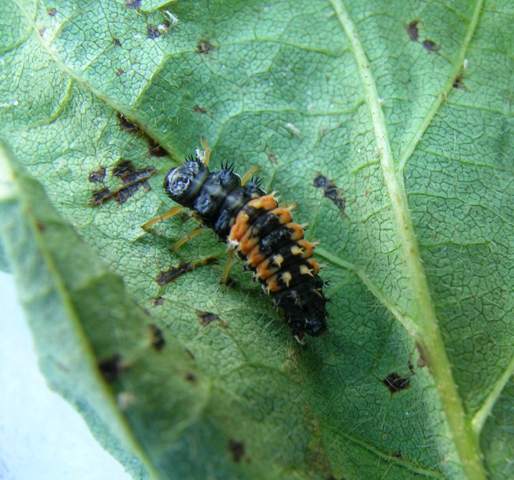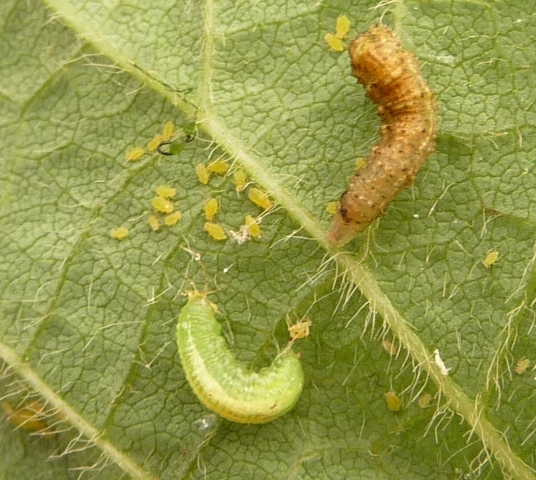Manitoba Insect & Disease Update: August 18, 2015
Summary
Plant Pathogens: There is a lot of sclerotinia and blackleg being found in canola as farmers stage it for swathing. Some alternaria is being detected as well.
Fusarium levels in wheat have generally been low. Some root rot is showing up in soybeans where excess moisture has been present.
Insects: Scouting for soybean aphids continues; they are present in many fields. Populations above the economic threshold and insecticide applications have occurred, but have been limited. High levels of natural enemies have been reported in some fields.
Soybeans
Effect of temperature on soybean aphids: As with other insects, soybean aphids have a temperature range where development is optimum, with development being slower below and above the optimum range. For soybean aphid the temperature for optimum growth is around 27C. At lower temperatures development will be slower. At the other extreme, in experiments where soybean aphids were kept at high temperatures, nymphs did not complete development at 35C and died within 11 days (J. Econ. Entomol. 2004: 854-861).
Soybean aphid consumption by natural enemies: High levels of natural enemies have been reported by some monitoring levels of soybean aphid. Predaceous insects are the easiest natural enemies to recognize; levels of parasitism and insect pathogens are not often as obvious but with training can be estimated as well. Lady beetles, lacewings, and larvae of hover flies are some of the common and easily recognizable predators in soybean fields. When checking soybean fields, consider whether the aphid populations are increasing or decreasing, and the level of natural enemies present.


Figure 1. Larva of multicoloured asian lady beetle Figure 2. Larvae of 2 species of hover flies and soybean aphids
Some have been sending in photos of hover fly larvae, which may be found in many crops where aphids are present, wondering what they are. Although the adults, which are good bee mimics, are easy to recognize, the larvae may not be as well known. Note that hover fly larvae (figure 2) are legless, and narrow towards the head. There are different species that can vary in colour, often brown or green.
Common species of lady beetle that may be noted in soybean fields include the sevenspotted lady beetle, Coccinella septempunctata, and the multicoloured asian lady beetle, Harmonia axyridis. A study looking at predation rates by these two species of lady beetles on soybean aphids found that for sevenspotted lady beetle third instar larvae could each consume up to 105 aphids per day, adult females could each consume up to 115 soybean aphids per day, and each adult male up to 78 aphids per day when soybean aphids are high. (Environmental Entomology: 2009. 708-714). For multicoloured asian lady beetle, third instar larvae could each consume up to 112 aphids per day, adult females could each consume up to 95 soybean aphids per day, and each adult male up to 53 aphids per day when soybean aphids are high.


Figure 1. Larva of multicoloured asian lady beetle Figure 2. Larvae of 2 species of hover flies and soybean aphids
Some have been sending in photos of hover fly larvae, which may be found in many crops where aphids are present, wondering what they are. Although the adults, which are good bee mimics, are easy to recognize, the larvae may not be as well known. Note that hover fly larvae (figure 2) are legless, and narrow towards the head. There are different species that can vary in colour, often brown or green.
Sunflowers
When does it become too late to manage Lygus bugs in sunflowers? In research trials in North Dakota, damage to sunflower heads by Lygus bugs was approximately twice as severe when feeding occurred at late bud and early bloom compared to stages when heads had completed flowering. At these earlier stages, the feeding will injure the kernels and the destruction of the cells will result in the characteristic depressions and browning of the kernel. If adult densities reach the economic threshold, lygus bug management should be initiated prior to or at the beginning of the bloom stage.
When flowering has finished (by R6) the seeds are probably too mature to sustain damage any longer.
Insect Monitoring Programs
Grasshopper Survey: A reminder for those participating in the grasshopper survey, that counts are done during August, when the majority of grasshoppers are in the adult stage.
Agronomists and farmers who would also be interested in estimating grasshopper numbers in the fields they are in and have this information included in the survey are encouraged to see the survey protocol for more details of the survey and where to send data. Estimates of grasshopper levels can be collected during regular farm visits.
"Estimates" of grasshopper populations is stressed as it will not be possible to accurately count grasshoppers along a field edge or ditch area as they will be moving around as you get near the area of the count. But an estimate of what is present gives us some idea of the relative numbers that are present in different areas.
Data from the survey, along with weather data during the egg laying period of the grasshoppers, is used to produce a forecast map for 2016.
The protocol and data sheet for the grasshopper survey is at: http://www.gov.mb.ca/agriculture/crops/insects/mb-grasshopper-survey.html
Compiled by:
John Gavloski, Entomologist
Manitoba Agriculture, Food and Rural Development
Phone: (204) 745-5668 Fax: (204) 745-5690.
To report observations on insects or plant pathogens that may be of interest or importance to farmers and agronomists in Manitoba, please send messages to the above contact address.
To be placed on an E-mail list so you will be notified immediately when new Manitoba Insect and Disease Updates are posted, please contact John Gavloski at the address or numbers listed above.
Manitoba Insect & Disease Update: August 18, 2015
John Gavloski, Entomologist
Manitoba Agriculture, Food and Rural Development
Phone: (204) 745-5668 Fax: (204) 745-5690.
To report observations on insects or plant pathogens that may be of interest or importance to farmers and agronomists in Manitoba, please send messages to the above contact address.
To be placed on an E-mail list so you will be notified immediately when new Manitoba Insect and Disease Updates are posted, please contact John Gavloski at the address or numbers listed above.
Manitoba Insect & Disease Update: August 18, 2015

